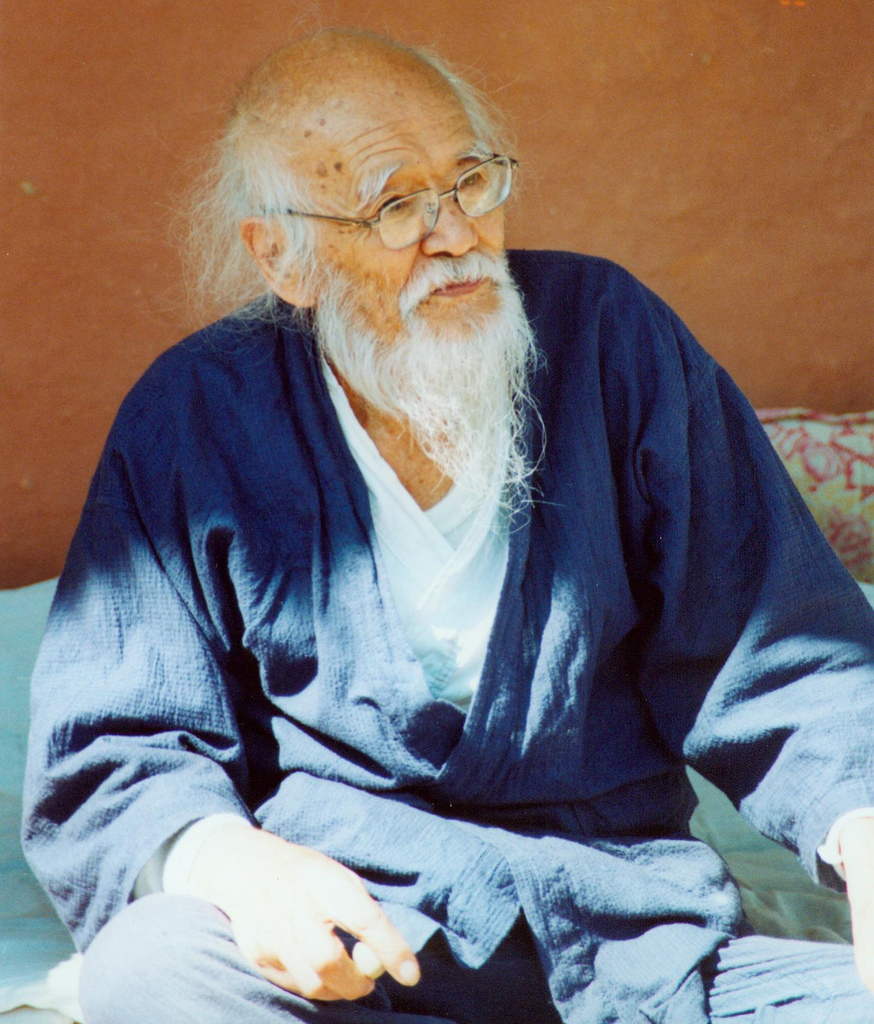
I still recall my first reading of the late Masanobu Fukuoka‘s ‘The One-Straw Revolution‘ (tr. 1978.) Illuminating experience does not quite do justice to the eye-opener that it was – apart from his radical, quietly determined challenge to all known forms of destructive agricultural ideas and techniques known to man; what lingered on was his overarching back-to-nature philosophy that permeated his thought and action – “It proceeds from the conviction that if the individual temporarily abandons human will and so allows himself to be guided by nature, nature responds by providing everything.” His revolution was also guided by his consistent gentle humility – the ability to not only abandon human will, but also abandon his imprint on all that he does, for he may as well be an insect balancing on a blade of grass or a straw in the moonlight. Short of romanticizing, nothing takes away from his remarkable sixty five years of toiling away in a small farm in Japan, developing a unique method of farming, that will fire up the zeal, imagination and be a call-to-action for generations worldwide, his work having been translated to all major languages. “This method completely contradicts modern agricultural techniques. It throws scientific knowledge and traditional farming craft right out the window. With this kind of farming, which uses no machines, no prepared fertilizer, and no chemicals; it is possible to attain a harvest equal to or greater than that of the average Japanese farm. The proof is ripening right before your eyes.” What makes Fukuoka’s revolution admiration worthy is also because he crosses over from the realm of spirit-philosophy-theory to actual practical action and demonstration, more than the required many ‘proofs-of-concept.’ He maintained that healing of the land and the healing of the human spirit is the one and the same process, and demonstrated a manner of living and a manner of farming in which that process can unfold. What follows is an overview of Fukuoka’s philosophy and work. Watch and listen in. (The video is slightly dated, and the Japanese inflected English may get challenging at times.)

 With all the magical places you are checking off your bucket list! I want to know how to be you :)
With all the magical places you are checking off your bucket list! I want to know how to be you :) Photo gallery
Photo gallery Photo gallery
Photo gallery Photo gallery
Photo gallery Love your site Milindo. I was excited to see you displaying my husband’s watermelon carvings
Love your site Milindo. I was excited to see you displaying my husband’s watermelon carvings Utterly Brilliant! I just thought you should know that you have engaged another human with your work here, and for that I thank you!
Utterly Brilliant! I just thought you should know that you have engaged another human with your work here, and for that I thank you! Photo gallery
Photo gallery Hi Milindo, hope you are inspiring many more around you…wherever you are!
Hi Milindo, hope you are inspiring many more around you…wherever you are! Milindo Taid – ace teacher, rockstar guide to my projects at film school, guitarist and photographer too. Really good human being as well
Milindo Taid – ace teacher, rockstar guide to my projects at film school, guitarist and photographer too. Really good human being as well You’re a role model sir, such awesomeness !!! :D
You’re a role model sir, such awesomeness !!! :D Photo Gallery
Photo Gallery Photo gallery
Photo gallery You are inimitable!
You are inimitable! Your courses were always the best. By the way, just went through a bit of your website. It’s great! Some good stuff in there that I wouldn’t normally chance upon
Your courses were always the best. By the way, just went through a bit of your website. It’s great! Some good stuff in there that I wouldn’t normally chance upon hope you’re changing the world as always :)
hope you’re changing the world as always :) Photo gallery
Photo gallery Just detected your blog: impressive. wishing you continued inspiration and health.
Just detected your blog: impressive. wishing you continued inspiration and health. love ur pics…they are like those moments which u capture in your mind and wished u had a camera right at that moment to capture it…but u actually do capture them :) beautiful…!!!
love ur pics…they are like those moments which u capture in your mind and wished u had a camera right at that moment to capture it…but u actually do capture them :) beautiful…!!! Photo gallery
Photo gallery This is by far amongst the best curated creative content sites out there and the eye and vision of one man, when good, works better than any funded team. Inspired enormously once again :)
This is by far amongst the best curated creative content sites out there and the eye and vision of one man, when good, works better than any funded team. Inspired enormously once again :) Photo gallery
Photo gallery great blog :)
great blog :) Photo gallery
Photo gallery Photo gallery
Photo gallery OMG its like a painting!! you have taken photography to another level!!!
OMG its like a painting!! you have taken photography to another level!!! We need more teachers like you :)
We need more teachers like you :) I was just looking at your website… amazing it is… full of knowledge as always..
I was just looking at your website… amazing it is… full of knowledge as always.. Grt milindo. eachtime want to check out something good on net…know where to go now!
Grt milindo. eachtime want to check out something good on net…know where to go now! Photo gallery
Photo gallery #NowFollowing @Milindo_Taid One of the most influential n interesting mentor from my design school. Always loaded. :)
#NowFollowing @Milindo_Taid One of the most influential n interesting mentor from my design school. Always loaded. :) Photo gallery
Photo gallery Your website is full of delightful posts. I’m going to have to watch where my time goes when I’m visiting! :)
Your website is full of delightful posts. I’m going to have to watch where my time goes when I’m visiting! :) You’ll love this site by the awesome Milindo Taid
You’ll love this site by the awesome Milindo Taid You are the only faculty member I could connect to!
You are the only faculty member I could connect to! Photo gallery
Photo gallery Guitar in your hand reminds me of the MCRC days! You are terrific… :)
Guitar in your hand reminds me of the MCRC days! You are terrific… :) i really like your blog – good interesting stuff as always !
i really like your blog – good interesting stuff as always ! Photo gallery
Photo gallery So glad you enjoyed my photos, really honored to be featured on your blog. thank you sir!
So glad you enjoyed my photos, really honored to be featured on your blog. thank you sir! Its really good to see you Milindo, with such awesome stuff from you as usual.. loved your blog as well!
Its really good to see you Milindo, with such awesome stuff from you as usual.. loved your blog as well! Still a fan of your unique and sweet finger strum on acoustic guitar. It made an ordinary guitar sound great. Would just love to see and hear one of those too.
Still a fan of your unique and sweet finger strum on acoustic guitar. It made an ordinary guitar sound great. Would just love to see and hear one of those too. Photo gallery
Photo gallery Never thought I’d say this, but it was the most interesting classes I’ve sat in.. and of course, the day you played Sultans of Swing for us. Hope you continue to influence the next generations with your dynamic yet simple teachings.
Never thought I’d say this, but it was the most interesting classes I’ve sat in.. and of course, the day you played Sultans of Swing for us. Hope you continue to influence the next generations with your dynamic yet simple teachings. Milind never told u but u were my first true inspiration….I almost learnt the guitar watching u play…..thanx for being there
Milind never told u but u were my first true inspiration….I almost learnt the guitar watching u play…..thanx for being there I discover TL of a writer and respected intellectual, with a tolerant, global conscience: @GhoshAmitav – tx @Milindo_Taid
I discover TL of a writer and respected intellectual, with a tolerant, global conscience: @GhoshAmitav – tx @Milindo_Taid Photo Gallery
Photo Gallery Photo gallery
Photo gallery Photo gallery
Photo gallery You are awesome :)
You are awesome :) Oldest operating bookstore
Oldest operating bookstore veryveryinterestingwebsite.have been visiting! thankyou!
veryveryinterestingwebsite.have been visiting! thankyou! Absolutely amazing blog – a chest full of treasure.
Absolutely amazing blog – a chest full of treasure. Photo Gallery
Photo Gallery